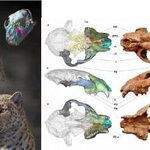Ecology & Zoology

Hunters are often regarded as the enemy by animal activists but in reality the opposite is true; legal hunting helps sustain populations, even trophy hunting.
Trophy hunting occurs in 9 of the 28 African countries that have wild populations of lions. Hunting is legal in these countries but quotas are set to restrict the numbers of lions that can be killed.
Though such hunting is controversial in first world countries, evidence shows it helps conservation efforts because it generates substantial revenue - hunting is also an important cultural pastime in the US. Deer hunting licenses in…

The black Périgord truffle is a fungus that grows underground around the roots of oak and hazelnut trees in winter. It has become a staple during holidays in France, where cooks slip bits of it under the skin of roasting turkeys to add a luxurious flavor.
Holiday cooking would not be complete with an examination of why things work and so scientists are revealing the secrets that give the culinary world's "black diamond" its unique, pungent aroma. The results could also lead to better ways to determine the freshness and authenticity of the pricey delicacy.
Mark Baker, Shoba…

Type E botulism, a neuromuscular disease caused when birds eat fish infected with toxin-producing bacteria, has become a deadly menace that stalks the loons, gulls and other water birds of the Great Lakes region.
Cases of the disease are on the rise, killing approximately 10,000 more waterfowl in 2007 than when it was first reported in 1963.
To understand die-off origin and distribution, ocean engineers from the Florida Atlantic University Institute for Ocean Systems Engineering in Dania Beach, Florida are using their expertise in experimental hydrodynamics. They have teamed with…

Will fish stop swimming due to global warming?
It's not the craziest mainstream media headline you are likely to read, but researchers from the ARC Centre of Excellence for Coral Reef Studies at James Cook University say that fish share something in common with people; when it's hot, they just want to lay around.
Researcher Dr. Jacob Johansen noted that fish rely on swimming for almost all activities necessary for survival, including hunting for food and finding mates. "However, global warming may reduce the swimming ability of many fish species, and have major impacts on their ability…
The deadly amphibian disease chytridiomycosis has caused the extinction of Darwin's frogs, according to scientists from the Zoological Society of Londonand Universidad Andrés Bello in Chile.
Conservation scientists found evidence of amphibian chytridiomycosis causing mortality in the the northern Rhinoderma rufum endemic to Chile, and linked this with both the population decline of the southern Rhinoderma darwinii from Chile and Argentina, including from undisturbed ecosystems.
Darwin's frogs were named after Charles Darwin who first discovered R. darwinii in 1834 in…

When mother mice compete socially for mates in a promiscuous environment, their sons play hard - they also die young.
More urinary pheromones attract more females but smelling sexier shortens their lives.
Male mice whose parents freely competed for mates in seminatural "mouse barns" produced 31 percent more major urinary proteins or MUPs – sex attractants called pheromones – than male mice from caged monogamous parents. Pheromone output increased even though the male offspring never competed socially.
Yet the male mice that produced more pheromone had shorter lifespans in another recent…

Wolves likely were likely domesticated by European hunter–gatherers over 18,000 years ago and gradually evolved into dogs, according to a genetic analysis. There is debate over when dogs were domesticated and whether it was linked with the development of agriculture or it occurred much earlier. The new work claims that dogs were domesticated between 18,000 and 32,000 years ago.
The researchers studied 10 ancient "wolf-like" animals and eight "dog-like" animals, mostly from Europe. These animals were all more than 1,000 years old, most were thousands of years old, and two were more than…

Panthera blytheae is the oldest big cat fossil ever found and fills a significant gap in the fossil record, according to results announced today.
The Panthera blytheae skull was excavated and described by a team led by Jack Tseng, a postdoctoral fellow at the American Museum of Natural History (AMNH) in New York.
DNA evidence suggests that the so-called "big cats" – the Pantherinae subfamily, including lions, jaguars, tigers, leopards, snow leopards, and clouded leopards – diverged from their nearest evolutionary cousins, Felinae (which includes cougars, lynxes, and domestic cats), about 6.…

Scientists have described a new species of scorpion, Euscorpius lycius, from the regions of the Muğla and Antalya Provinces in Southwestern Turkey, what was once known as ancient Lycia, fought over by Persians and Greeks for centuries due to it being a good source of wheat and timber. The last remaining Greeks were forced to leave after the 1919-1922 war with Turkey.
Euscorpius is a genus of scorpions, commonly called small wood-scorpions. As their name suggest these scorpions don't impress with a large size, the biggest representative being around 5 cm long. The group is widespread in…

We can't identify 99 percent of the species that have gone extinct so trying to keep everything we do know about from going extinct is tilting at nature's windmill.
But if we played Noah and had a giant ark and wanted to engage in ecological Jenga (build a tower, then remove blocks without causing the tower to collapse), which species should we save first to prevent a collapse in ecological function?
An international research team has developed mathematical tools that can estimate which species are most influential in a food web and they found that long-lived, generalist top predators — such…